Jennifer Bohnhoff's Blog, page 44
November 11, 2015
Henry Hopkins Sibley: Would be conqueror of New mexico
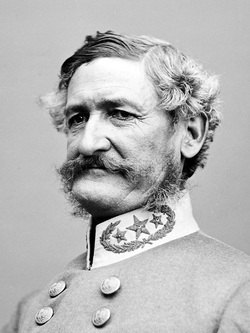 This is National Novel Writing Month, and I’m participating by writing a novel set in New Mexico during the Civil War. Today I got to a scene in which one of my characters, a young Texan named Jemmy Martin, sees Major General Henry Hopkins Sibley riding into San Antonio with his adjutants:
This is National Novel Writing Month, and I’m participating by writing a novel set in New Mexico during the Civil War. Today I got to a scene in which one of my characters, a young Texan named Jemmy Martin, sees Major General Henry Hopkins Sibley riding into San Antonio with his adjutants:"At their center was a fine looking man with silver hair that caught the morning sun and made him look as if a halo circled his head. He had a great, bushy mustache, sideburns, and sad, drooping eyes that made Jemmy feel as if this man had seen all the sorrow the world had to offer and had learned how to push through it. Jemmy instantly felt as if he could follow the man anywhere."
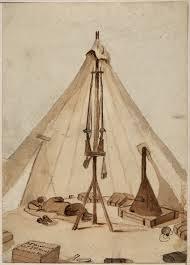 Many young men of the Confederacy were awestruck by Sibley. Many contemporary records attest to his natural charisma and ability to inspire people with his words.
Many young men of the Confederacy were awestruck by Sibley. Many contemporary records attest to his natural charisma and ability to inspire people with his words. Born in Natichoches, Louisiana in 1816, he had graduated from West Point and become a career soldier. He was also an inventor, famous for the Sibley Tent and Sibley Stove, both used widely by troops in both the north and the south throughout the Civil War.
At the time of the outbreak of Civil War, Sibley was a Major stationed at Fort Union, in northern New Mexico. He promptly deserted to join the Confederacy. A diary of a Union soldier stationed in Albuquerque says that, while passing through in a stagecoach, Sibley stuck his head out the window and shouted “Boys, I'm the worst enemy you have!”
Sibley was on his way to Richmond, Virginia, where he talked Jefferson Davis, the President of the Confederate States, into commissioning him as a brigadier general and authorizing him to recruit a brigade of volunteers in central and south Texas. Sibley’s plan was to march to El Paso, then occupy New Mexico, seize the rich mines of Colorado Territory, turn west through Salt Lake City, and capture the seaports of Los Angeles and San Diego and the California goldfields, all while living off the land. His battle cry, “On to San Francisco!” inspired 2,000 men to join his campaign. By early fall of 1861, Sibley had three regiments of what he named The Army of New Mexico, plus artillery and supply units, camped on the outskirts of San Antonio.
But Sibley’s plan did not go as well as he had hoped. One reason is that the population did not respond to his invasion the way he had hoped. During his Army service in New Mexico, he had seen that both indigenous New Mexicans and Hispanic New Mexicans disliked the presence of the American Army in their territory. He therefore expected them to support him with food for both his troops and his pack animals and horses. He was convinced that recent immigrants from the southern states would join his ranks. He also forecast that the Union troops in New Mexico would desert to his banner.
He was right to an extent on two of these three groups; many Union soldiers with ties to the south did abandon their posts to join Sibley, and many citizens were Confederate sympathizers, particularly in the southern part of the state. However, while most Hispanics and Indians didn’t like the Americans, they truly hated Texans, and they considered Sibley’s Army Texan, not Confederate. The citizens of New Mexico had no intention of supporting an invading army of Texans.
Futhermore, Sibley had a little personal problem; Sibley drank. He drank so much that one of his officers later called him “a walking whiskey keg.” By the time the Army of New Mexico had reached El Paso, Sibley’s once brilliant speeches had become rambling, confused rants, and even the common soldiers knew that their leader was affected with a severe and recurring case of “barleycorn fever.” Halfway through the Battle of Valverde, Sibley turned the field over to his second in command and crawled into an ambulance, too incapacitated to lead. Sibley was not even present at the Battle of Glorietta Pass. While this battle, often called the Gettysburg of the West, was being fought, the General was nursing a hangover back in Santa Fe.
By the time the ragged remains of the Army of New Mexico had limped its way back to Texas, none of its embittered soldiers felt like Jemmy had on that first day he’d seen the General ride his horse through San Antonio. They had followed him into the wilderness, only to find that his grandiose dreams were nothing but a mirage.
Published on November 11, 2015 19:13
October 24, 2015
Fan Mail!
 This week I got one of the greatest gifts a writer can get:
This week I got one of the greatest gifts a writer can get: a packet of fan mail.
My friends, family and fans are great people, and they are generous with their praise and opinions, so this isn't the first time I've gotten fan mail before.
But this is the first time that I've received a whole packet of fan mail: 19 pieces of it at once!
Mrs. Blaine, a fifth grade teacher Sundance Elementary School in Los Lunas, reads to her students for fifteen minutes a day, every day, right after recess. Lucky me: she's just finished reading them my Civil War novel, and as a follow up she had her students write letters to me.
The letters were interesting: full of kind and encouraging words (things like "the detail in the book puts a little movie on in my mind" and "this is my new favorite book"), advice (one boy wrote "I think you might have to take all the violence down an notch just saying." In this time of violent video games and graphic news programs, it's nice to know that violence still bothers some kids), and lots of questions (Did Sarah and Martin get married? Did Micah survive?) The most frequent question was one I had never expected; what kids wondered more than anything else was who, Union or Confederate, was responsible for the death of Beatrice the cow.
I am writing responses to each child's letter. I hope that their teacher will be able to arrange a class visit for me; I would love to show these students pictures of the Gettysburg battlefield, the farms and orchards mentioned in the book, and of some of the minor characters. Then I can deliver the responses in person.
Published on October 24, 2015 15:58
October 6, 2015
Naming Characters
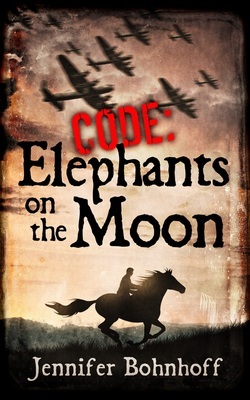 I recently answered an email from a fan who wondered where I got the names for the characters in Code: Elephants on the Moon. Since he wondered, I thought perhaps others might wonder about this as well, so I'm answering his question here.
I recently answered an email from a fan who wondered where I got the names for the characters in Code: Elephants on the Moon. Since he wondered, I thought perhaps others might wonder about this as well, so I'm answering his question here. I've got to admit I don't work too hard at naming my characters. Most of the times, as crazy as it sounds, they name themselves. Unlike characters in a play, who do what the script demands, characters in a novel-in-progress often take on a life of their own. My characters tell me a lot about themselves. As I ponder plot, my characters reveal their personalities, some interesting character traits, their looks, and even their names. Sometimes they haul off and do things that change the direction of my story in ways that I hadn't intended.
The name of my main character, Eponine is French, but it comes from the Breton word Epone or Epona. This works well for a girl whose red hair suggests Breton blood. Bretons are Celtic in origin, making them more closely related to the Welsh and Irish than their French and Norman neighbors. Epona is the name of the Celtic horse goddess, a fact that makes the name even more appropriate for my character. It is also a name with a literary heritage. Victor Hugo used the name for one of his characters in Les Miserables.
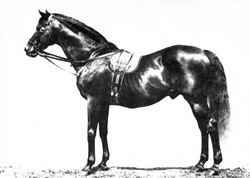 Galopin. Public domain from wikicommons. Eponine's horse is named Galopin, which is also a name I didn't make up. In French, a galopin is a monkey or scamp, neither of which describe the personality of the sway-backed, dish-faced Breton horse in my book. The British have had a championship horse named Galopin, who was a much better-looking horse than my character. There is also an early French science fiction writer named Arnould Galopin, who is kind of the Jules Verne of the French speaking world. He was not an inspiration at all in the naming of my horse. Mostly, I named my horse Galopin because the word sounded like the English word 'galloping' to me. And because the horse told me to call him that.
Galopin. Public domain from wikicommons. Eponine's horse is named Galopin, which is also a name I didn't make up. In French, a galopin is a monkey or scamp, neither of which describe the personality of the sway-backed, dish-faced Breton horse in my book. The British have had a championship horse named Galopin, who was a much better-looking horse than my character. There is also an early French science fiction writer named Arnould Galopin, who is kind of the Jules Verne of the French speaking world. He was not an inspiration at all in the naming of my horse. Mostly, I named my horse Galopin because the word sounded like the English word 'galloping' to me. And because the horse told me to call him that.
Published on October 06, 2015 20:20
September 19, 2015
The Changing of the plates
 I love fall, even if I'm not quite sure when to celebrate its arrival.
I love fall, even if I'm not quite sure when to celebrate its arrival. Does fall begin when school begins? Here in New Mexico, that would move fall to the middle of August.
Is fall when supermarkets begin roasting green chili in their parking lots at the end of August? After Labor Day, even though it's still in the 90s in the afternoon? When the State Fair begins or ends? On the Autumnal Equinox, which was always on September 21 when I was a kid but has mysteriously slipped to a different day? In early October, when the International Balloon Fiesta comes to town and the sky fills with a riot of noise and color? Or the middle of October, when the air finally cools down and the aspens turn golden? You may commemorate the change of seasons by putting out a wreath made with orange and yellow leaves, or setting up a scarecrow and pumpkin by your front door, but I restack my plates.
This is a fairly new tradition for me. When my kids were little, everyone in the house had dibs on a different colored plate. This was convenient, because I could at a glance figure out who'd left his cereal bowl in front of the TV and who was hoarding crockery in his room. But the boys have grown up and out moved out, and I am left with a stack of multicolored Fiesta ware and the desire to do something with them other than look at the colors and miss the boys who used to eat off them.
 So I've taken to restacking my plates with each change of season. Since Memorial Day, my blue, white, yellow, and burgundy plates have been on the top of the stack, and my kitchen table's place mats have looked distinctly patriotic.
So I've taken to restacking my plates with each change of season. Since Memorial Day, my blue, white, yellow, and burgundy plates have been on the top of the stack, and my kitchen table's place mats have looked distinctly patriotic.  Now that fall is here, or is coming, the blue and white plates have rotated to the bottom of the stack and the orange, yellow and green plates have risen to the top. Next month I'll "redecorate" by flipping over the place mats, revealing the side that has pumpkins printed on a black background.
Now that fall is here, or is coming, the blue and white plates have rotated to the bottom of the stack and the orange, yellow and green plates have risen to the top. Next month I'll "redecorate" by flipping over the place mats, revealing the side that has pumpkins printed on a black background.Restacking my plates doesn't put me into the Martha Stewart hall of fame, but it makes me happy. What traditions do you do to celebrate the changing of the season?
Published on September 19, 2015 11:14
August 31, 2015
By the numbers
 Never, ever trust me on a number.
Never, ever trust me on a number. If I tell you that something happened on a certain date, I've probably have inverted a number. Jamestown, for instance: was it settled in 1619 or 1691? Was the Magna Carta signed in 1215 or 1521? Right now the teacher I teach New Mexico history to 6th, no, 7th graders is quaking in her boots because she just realized how much misinformation I put out. If I'm lucky, my students will manage to forget everything I mis-teach.)
If the number isn't a date, but a quantity or a price, I've probably added or subtracted a 0. If I was a realtor I'd probably get in trouble for accepting a check for twenty thousand to pay for a two hundred thousand dollar house.
Once (a number I can count to with some assurance of getting it right) my husband asked me to buy fertilizer for the back lawn. The guy at the store insisted I tell him how big my lawn was. I prevaricated. He suggested I guess. So I did. I guessed that my small suburban yard was a hundred yards by thirty yards. We didn't need to buy fertilizer again for 8 years - and when we did you can bet my husband didn't send me to buy it.
Good thing that was pre 9/11, or I would have had fed agents stalking my garage and wondering if I was building a bomb.I want to talk numbers with you, beginning with the fact that I have a love/hate relationship with them.
But even though I'm awful with numbers, I'm fascinated by them, especially when they are related to statistics or standings or one kind or another. After every race I've ever run I've studied the results, trying to analyze my performance. Even with my limited mathematical powers I know that if I was 2,347th out of 5,328 overall, I was middle of the pack. But I still wonder how I placed among women 50-55 who were named Jennifer and happened to have three sons. Race statistics are never specific enough.
I have won 1st in my age category. I did it once, during a 5K for Alzheimer's. Ironically I don't remember what my time was.
So here are some recent statistics for my books. Code: Elephants on the Moon is currently #877,464 among books in the paid Kindle store. The Bent Reed is 1,368,709th and On Fledgling Wings is 1,006,140th. I have no idea how many books there are in total. For all I know, the Bent Reed might be the worst selling book on Amazon, but I suspect there are many more underneath it.
There are currently 12 reviews on Amazon for Code: Elephants, 5 for The Bent Reed, and 2 for Fledgling. They average in the 4s, a number I am both proud of and grateful for. A more experience writing friend tells me that the "magic" number of reviews is 20; when a book gets that many, the good folks at Amazon pay attention a little differently to the title. I'm not sure what that all means, but if you've read any of my books and and liked it, would you help me attain 20 reviews?
To sweeten the deal, I'm going to be offering a little incentive. Check back here soon to see what.
Published on August 31, 2015 11:53
August 18, 2015
Magical Moments, Magical��things
They say the best things in life are free, and I'm inclined to believe it, especially after a day like last Sunday, or a gift like the last one that came in the mail.
Sunday at the Bohnhoff house means family dinner. Usually my 93 year old mother in law, my oldest son, his wife, and their two and a half year old daughter join my husband and me. During the summer we eat out on our shady, east-facing back porch. The granddaughter goes back and forth between the dinner table and the swing set. My husband gets out the T ball stand and we watch a little batting practice. But as we ate last Sunday, we watched the sky darken with rumbling, boiling clouds.
The skies opened up just after dessert, drenching the thirsty lawn and cooling the air. After a while the rain lessened and a glorious double rainbow filled the eastern sky. Wanting to get a better view, I scooped up my granddaughter and headed out to the street. Once we were there, I realized that the gutters were running - something that doesn't happen often here in the desert. I put my grand daughter down and showed her how a leaf placed in the water would zip away, and we ended up spending the next ten or fifteen minutes hunkered down in the gutter, me sending leaf boats downstream to a little girl who squealed with delight as she pulled them back out. The experience was free, and perhaps one of the richest and most precious of the summer. I hope she will remember the day long after I have passed from this life. The gift I got a few weeks ago wasn't entirely free for my husband's cousin Ross. I'm not sure how much he paid for it, but I'm sure it wasn't much. And yet, it is among my most priceless treasures.
The gift I got a few weeks ago wasn't entirely free for my husband's cousin Ross. I'm not sure how much he paid for it, but I'm sure it wasn't much. And yet, it is among my most priceless treasures.
I'd sent Ross an announcement when my youngest son graduated from West Point this spring. Enclosed with the announcement was a paper asking no gifts except the gift of prayer for my son and those he would soon be leading. Instead of honoring my request entirely, Ross sent a package with this magic wand and a letter explaining why he sent it. You can bet I'll be holding on to this magic wand. It will be in a prominent place if and when my son is deployed.
Here's the letter Ross sent. Here's wishing you some magical moments.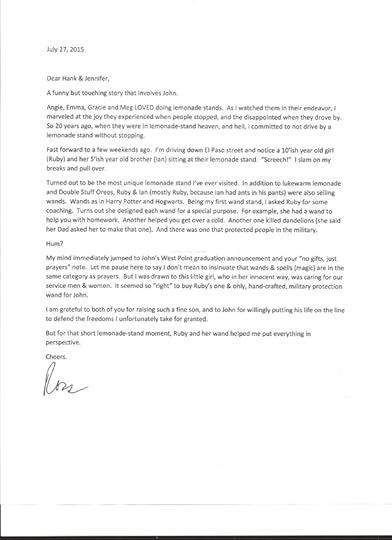
Sunday at the Bohnhoff house means family dinner. Usually my 93 year old mother in law, my oldest son, his wife, and their two and a half year old daughter join my husband and me. During the summer we eat out on our shady, east-facing back porch. The granddaughter goes back and forth between the dinner table and the swing set. My husband gets out the T ball stand and we watch a little batting practice. But as we ate last Sunday, we watched the sky darken with rumbling, boiling clouds.
The skies opened up just after dessert, drenching the thirsty lawn and cooling the air. After a while the rain lessened and a glorious double rainbow filled the eastern sky. Wanting to get a better view, I scooped up my granddaughter and headed out to the street. Once we were there, I realized that the gutters were running - something that doesn't happen often here in the desert. I put my grand daughter down and showed her how a leaf placed in the water would zip away, and we ended up spending the next ten or fifteen minutes hunkered down in the gutter, me sending leaf boats downstream to a little girl who squealed with delight as she pulled them back out. The experience was free, and perhaps one of the richest and most precious of the summer. I hope she will remember the day long after I have passed from this life.
 The gift I got a few weeks ago wasn't entirely free for my husband's cousin Ross. I'm not sure how much he paid for it, but I'm sure it wasn't much. And yet, it is among my most priceless treasures.
The gift I got a few weeks ago wasn't entirely free for my husband's cousin Ross. I'm not sure how much he paid for it, but I'm sure it wasn't much. And yet, it is among my most priceless treasures.I'd sent Ross an announcement when my youngest son graduated from West Point this spring. Enclosed with the announcement was a paper asking no gifts except the gift of prayer for my son and those he would soon be leading. Instead of honoring my request entirely, Ross sent a package with this magic wand and a letter explaining why he sent it. You can bet I'll be holding on to this magic wand. It will be in a prominent place if and when my son is deployed.
Here's the letter Ross sent. Here's wishing you some magical moments.

Published on August 18, 2015 18:17
August 15, 2015
Adventures in research
 By Cliff from Arlington, Virginia, USA (A Young Woman Reading by Gustave Courbet) [CC BY 2.0 (http://creativecommons.org/licenses/b...)], via Wikimedia Commons I love being a writer.I love thinking about characters - who they are, how their backgrounds affect their decisions, how they will react to different circumstances, and how their reactions will affect their futures. I love thinking about plot - how the actions of one character creates a cascading domino affect, and where that affect leads, and what the whole ripple of actions means in the grand scheme of human experience. I love beginning a story and watching how it grows and changes and sometimes becomes something very different than the concept I had begun with. I love editing and deciding what to leave in and what to take out. But perhaps my favorite part of writing is researching.
By Cliff from Arlington, Virginia, USA (A Young Woman Reading by Gustave Courbet) [CC BY 2.0 (http://creativecommons.org/licenses/b...)], via Wikimedia Commons I love being a writer.I love thinking about characters - who they are, how their backgrounds affect their decisions, how they will react to different circumstances, and how their reactions will affect their futures. I love thinking about plot - how the actions of one character creates a cascading domino affect, and where that affect leads, and what the whole ripple of actions means in the grand scheme of human experience. I love beginning a story and watching how it grows and changes and sometimes becomes something very different than the concept I had begun with. I love editing and deciding what to leave in and what to take out. But perhaps my favorite part of writing is researching.I would probably be "researching" even if I wasn't writing: I just couldn't call it that. If I wasn't a writer, what I'd be doing would be called reading widely and deeply, and I'd have no excuse for why I do it except that I'm interested.
My research, like my writing, usually begins with a question or a topic. Swan Song, the book I intend to publish this fall, began with the question 'What if the Beowulf manuscript we know is just the first time a much older story was written down?' That led to 'What does it mean that Grendel the monster is called a son of Cain?" Those questions led to hundreds of hours of research on Beowulf, on Neanderthals, and a variety of related topics. I was lucky that I was working on a masters at the time, and that the NMSU library sent interlibrary loan books and scanned academic journal articles for its distance students.
Even though I've completed the manuscript, the topic still interests me, so I'm still "researching." Lately I found an excellent, informative B.A. Major Thesis entitled Female Characters in Beowulf posted on the internet. It was written by Petra Pochazkova, a student at Masaryk University in the Czech Republic. How I love living in the internet age!
Not all my research is online. Last fall my colleague Patrice Locke Lewis and I went to the ruins of Fort Craig, a 150 year old fort that saw action in the Civil War. Questions began circulating in my mind. What would it have been like to live at the fort in its heyday? Who was here? Ms. Lewis and I then proceeded south, to Las Cruces, where we visited a number of places including COAS, perhaps the greatest used book store in the southwest. I bought a stack of books related to the era and I began researching. Right now, I'm reading I Married a Soldier, a 1960s reprint of an 1890s memoir of a woman who accompanied her husband to his duty stations in New Mexico and Texas during the 1850s - 1870s. The reading is interesting, and I hope adds authenticity to the book I plan to begin writing this fall.
So here I sit, dividing my time between the Paleolithic period, the Anglo-Saxon era and the Civil War. Reading musty old books, academic papers, and flickering screens. Sometimes I have to put the research aside and reenter the present world, where meals need to be cooked, clothes washed, paychecks earned. But even as I take the car in to be serviced or sweep the front porch, a part of my mind is off on an adventure a thousand years or a thousand miles away.
Published on August 15, 2015 13:24
August 5, 2015
Buried in a Bacon Box
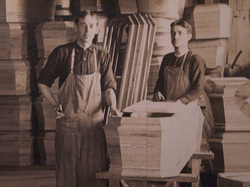 Towards the end of The Bent Reed, my middle grade novel set in Gettysburg during the Civil War, the main character finds her father working in his carpentry shop. He is sawing planks to make coffins, using the wood from Rose's Wood Lot, a small field that stood near what became known as Devil's Den. The woodlot had been the scene of fierce fighting. Most of the trees had lost all their leaves. Many had never recovered. Pa laughs sadly and says that it is fitting for men to be buried in wood that had died the same day as they. As Pa works, others are exhuming bodies hastily buried in fields and roadsides throughout the area. A month after this scene, President Lincoln will come to dedicate a new cemetery. He gives the Gettysburg Address at that dedication.
Towards the end of The Bent Reed, my middle grade novel set in Gettysburg during the Civil War, the main character finds her father working in his carpentry shop. He is sawing planks to make coffins, using the wood from Rose's Wood Lot, a small field that stood near what became known as Devil's Den. The woodlot had been the scene of fierce fighting. Most of the trees had lost all their leaves. Many had never recovered. Pa laughs sadly and says that it is fitting for men to be buried in wood that had died the same day as they. As Pa works, others are exhuming bodies hastily buried in fields and roadsides throughout the area. A month after this scene, President Lincoln will come to dedicate a new cemetery. He gives the Gettysburg Address at that dedication. Not every Union soldier got the benefit of being buried in a coffin. In I Married A Soldier, a memoir of Army life in the Southwest during the 1850s-1870s, Lydia Spencer Lane explains that wood was so scarce that it was customary to forgo burying coffins. She was told in Santa Fe that bodies were carried to the church in one, but removed and rolled in old blankets before being consigned to the tomb. Thus, coffins could be used and reused indefinitely.
This was not acceptable to people who had been raised in the East, who did everything within their power to create coffins for their dead. Ms. Lane explains that, when there was not enough lumber at hand to make a coffin, old packing boxes and commissary boxes were brought into requisition. She recalled one officer who died at a post in Texas and was carried to his final resting place in a very rough coffin which had marked, in great black letters along the side, "200 lbs. bacon."
 Jennifer Bohnhoff is the author of three middle grade historical fiction novels. She is currently researching, with plans to begin a new novel in the fall of 2015 which will be set in New Mexico during the Civil War.
Jennifer Bohnhoff is the author of three middle grade historical fiction novels. She is currently researching, with plans to begin a new novel in the fall of 2015 which will be set in New Mexico during the Civil War.
Published on August 05, 2015 10:01
July 28, 2015
American Pie
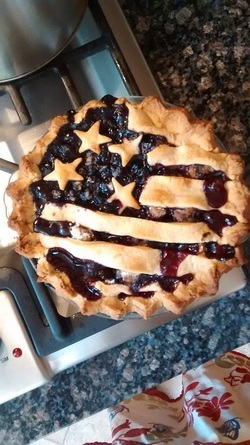 We may say "American as apple pie," but we Americans can't really claim pie as our own. The tradition of pie making came to the New World with our English ancestors, who encased not only fruits and custards, but meat, fowl, fish, eggs and vegetables in sturdy crusts and tender pastries.
We may say "American as apple pie," but we Americans can't really claim pie as our own. The tradition of pie making came to the New World with our English ancestors, who encased not only fruits and custards, but meat, fowl, fish, eggs and vegetables in sturdy crusts and tender pastries.During the Civil War era, only the rich and fashionable had a separate dessert course at dinner. The modest homes of farmers, artisans and shopkeepers served only one course. Apple and mince pies frequently appeared side by side with the meat, vegetables and bread.
They were also a common breakfast food, so if you've ever eaten leftover pie for breakfast (a favorite in the Bohnhoff household!) you are following a long standing tradition.
Housewives had practical reasons to make pies more frequently than cakes. Cakes required eggs, which were less plentiful in the winter than in the summer. The ingredients for pies: sugar, wheat flour, lard, plus fillings, were more readily available year round. During the winter months, dried or canned fruits were used to fill fruit pies.
The second edition of The Bent Reed, which I plan to put out during the summer of 2016, will have an appendix at the back that will begin with the information from this blog post. I'll publish a number of Civil War era recipes there, including peach (to recognize The Peach Orchard, a site of a major engagement during the Battle of Gettysburg), cherry and raspberry (because these were in season during the battle. Eating too many of them might have contributed to Robert E. Lee's problems.) and some savories as well. Most of these recipes will already have been sent to people on my friends, family and fans email list, which you can join on my website.
For now, you'll have to content yourself with just a pie crust recipe. This recipe is very versatile. It can be used for sweet or savory fillings, and can fill a number of different sized dishes. I rarely measure carefully, and that combined with the fact that flour acts differently in humid or dry conditions means that my crusts are never quite the same, but they are always good.
Good, Basic Pie Crust
Single Crust: (this size will fill two 6" pie plate is you're cooking for one or two)
1 1/3 c. flour
1/2 tsp. salt
1/2 c. shortening (I use Crisco, but lard or butter is authentic to the period)
2 1/2 to 3 TBS ice water
1/2 TBS cider vinegar
Double 8" Crust:
2 c. flour
1 tsp. salt
3/4 c. shortening
4 to 5 TBS ice water
1 TBS cider vinegar
Double 9" Crust:
2 2/3 c. flour
1 tsp. salt
1 c. shortening (I use Crisco, but you can use lard if you want to be authentic)
6 to 7 TBS ice water
1 1/2 TBS cider vinegar
Mix by hand method: Mix flour and salt. Cut in shortening until mixture resembles small peas. Sprinkle with water and vinegar, 1 tsp. at a time, mixing until it all sticks together. Refrigerate for about 10 minutes before rolling.
Food Processor Method: Dump flour and salt into processor bowl. Drop spoonfuls of shortening over the top. Pulse 2 or 3 times, until shortening is distributed. Pour vinegar into liquid dispenser and pulse one or two times. Continue adding water a TBS at a time until dough forms into a ball. Roll out on a flour covered piece of waxed paper.
Published on July 28, 2015 13:29
July 21, 2015
Getting The Navajo Long Walk Right for MG Readers
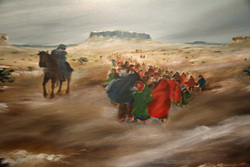 Painting, Bosque Redondo Visitor's Center In the 1860s, while most of the United States was focused on a bloody Civil War between the northern and southern states, a very different war was being fought in the western territories of New Mexico and Arizona.
Painting, Bosque Redondo Visitor's Center In the 1860s, while most of the United States was focused on a bloody Civil War between the northern and southern states, a very different war was being fought in the western territories of New Mexico and Arizona.Here, Native Americans felt the pressure as more and more white settlers moved into their lands. They retaliated by raiding the settlements. Finally, General James Carleton decided that the only way to protect white settlers was to restrict the nomadic lifestyle of the Navajos and Mescalero Apaches by relocating them to a reservation.
Led by the famous Indian scout Kit Carson, New Mexico's Volunteer Militia began rounding up the Mescalero Apache and Navajo Indians. Knowing that the Navajo would never surrender unless forced to, Carson followed a scorched earth policy. During the winter of 1863-1864 he burned Navajo crops and orchards, killed their livestock, destroyed their homes, and contaminated their water sources. Once they gave up, the Navajo were forced to walk, some as far as 300 miles, to Bosque Redondo.
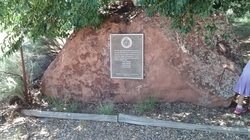 Treaty Rock, Bosque Redondo The Navajo remained at Ft. Sumner until June of 1868. During there time there they suffered from sickness, exposure and starvation. It is believed that during their incarceration between 500 and 1,500 Navajo died.
Treaty Rock, Bosque Redondo The Navajo remained at Ft. Sumner until June of 1868. During there time there they suffered from sickness, exposure and starvation. It is believed that during their incarceration between 500 and 1,500 Navajo died.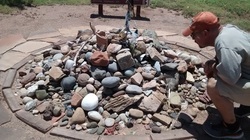 Stones and other mementos left by Navajo. I visited Bosque Redondo, in Ft. Sumner, New Mexico, in July 2015. The fort is completely gone now. The Memorial that is there honors the Native Americans who were interred there and documents their story. When I decided to find out what historical novels deal with this period in history, I found that there is very little written for this period. I found nothing representing the Mescalero experience, and only one book telling the Navajo story of the Long Walk. That one book is Sing Down the Moon, a Newbery Honor Book by respected author Scott O'Dell. Published in 1970, this novel has been a classroom staple for years.
Stones and other mementos left by Navajo. I visited Bosque Redondo, in Ft. Sumner, New Mexico, in July 2015. The fort is completely gone now. The Memorial that is there honors the Native Americans who were interred there and documents their story. When I decided to find out what historical novels deal with this period in history, I found that there is very little written for this period. I found nothing representing the Mescalero experience, and only one book telling the Navajo story of the Long Walk. That one book is Sing Down the Moon, a Newbery Honor Book by respected author Scott O'Dell. Published in 1970, this novel has been a classroom staple for years. 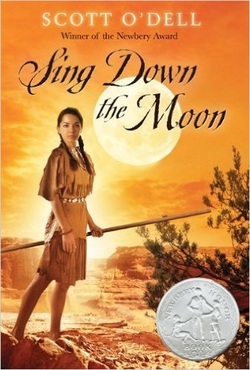 But not everyone likes this novel. A fellow teacher at my school who taught in Navajo country has told me that her students laughed at the many misrepresentations of Navajo customs and ideas.
But not everyone likes this novel. A fellow teacher at my school who taught in Navajo country has told me that her students laughed at the many misrepresentations of Navajo customs and ideas. One reviewer on Amazon who is from the four corners area wondered how much research O''Dell did. "I have never heard of mesquite growing around here or aspen in Canyon de Chelly or of the pueblo people eating dog meat and...... the owl a GOOD OMEN? I don't think so!!!! Any one from this area that has any knowledge of the Navajo culture knows that OWLS ARE NOT GOOD OMENS!!!" I think a telling of this story from the perspective of a Native American is long overdue.
Published on July 21, 2015 07:24



